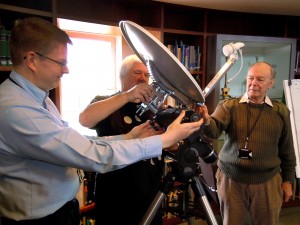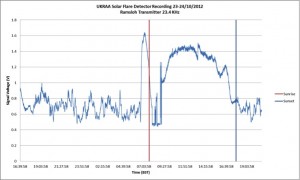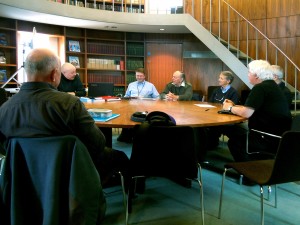October 27, 2012
Radio Astronomy Group Meeting – 27 October 2012
Report by: Grey Lipley
On a somewhat cold and blustery morning, ten eager individuals gathered in The Endeavour Room at the Royal Observatory Greenwich for what proved to be another very productive session, which began fairly promptly at 11.30am.
Some of us had arrived an hour earlier to transport our motorised HEQ5 mount and tripod together with other equipment from Flamsteed House to the South Building. One of my aims this time was to find a way of supporting the satellite dish so it would track the Sun and other radio sources in the heavens effectively. Some of the images here show us resolving the problem so that I can now construct a suitable bracket.
As usual we began the meeting with a roundup of news and an update concerning recent meetings Mike Meynell and I attended with those from the ROG. As far as radio astronomy is concerned, discussion had centred around two topics both concerning aerials and where to place them.
Unsurprisingly Rob Edward’s face had turned a little grey following my suggestion to use a high point on Flamsteed House and another on the Meridian Building to anchor a dipole antenna. However he really liked the idea of placing a VLF aerial and recorder somewhere in the Observatory so that once again Greenwich can be a source of live data. Where the equipment to do this will be housed remains unresolved.
For the present, Clive Inglis has cleared space in his garden shed to test the recently acquired VLF equipment shown in my last report. The group listened intently as he gave a detailed account of his success in obtaining a number of text book graphs showing changes in our upper atmosphere caused by the Sun’s activity, a remarkable achievement in such a short time. This encouraged many questions both specific and wide ranging.
If you study the graph where time is represented along the base line, you will notice the first part of the plot recorded during the night is relatively flat. This is followed by a peak which drops away almost immediately as the reference signal in Germany is turned off. The brief flat line that follows indicates down time followed by several small blips indicating daily tests before resuming transmission. It is the difference between this radio source and the signal obtained from our upper atmosphere that provides the data displayed here.
We then discussed where the VLF equipment could be sited more permanently as Clive’s garden retreat is a temporary solution. I reminded everyone that it could take months to reach agreement with the ROG especially as we hope to retrieve data via the internet and rather rashly suggested I might find room at home. However Mike thought this could lead to disharmony at No: 83 and my eventual ruin.
While picturing the consequences, I suggested we should break for refreshments before turning to the subject of direct solar observation using the satellite dish. You may remember that following our previous meeting, Adrian Challinor had agreed to investigate this aspect of radio astronomy. His findings were of immense interest and again promoted extensive discussion which formed the second half of the meeting.
It became apparent that the transceivers I had looked at may not have sufficient band width even though filtration was excellent and on-board power packs made them convenient. There was also a question regarding the need for a radio licence as these units could transmit and receive. In my defence I pointed out that the models in question were merely a suggestion to promote discussion.
With the group settled around the vast circular table, we discussed other options. One suggestion was to build our own receiver although I felt this could delay practical radio astronomy to a point where we might lose both momentum and optimism. Although an exciting prospect I suggested it was a project best tackled by those with specific interest.
Adrian suggested we should make a list of the objects we hoped to study using direct observation. The Sun was first as it is large, easily located and a fierce source of emissions. Next came the Moon which although much quieter is still easy to locate. Smaller again in size when viewed from Earth is Jupiter and finally most elusive of all, the centre of the Milky Way (in Sagittarius). Adrian agreed to find out which radio frequencies are best suited to observe these targets.
This information will enable us to search for a suitable radio receiver with the right level of sophistication that allows for further expansion. In the meantime Mike M suggested we look for a more immediate solution in order to begin practical observation directly.
The UKRAA website has several items that may help, such as their Controller which requires a USB to RS232 converter and additional cables. Once connected to a suitable computer they will enable us “to control observatory instruments and provide an autonomous logging facility so that several instruments can be observing at the same time without the need to keep the PC occupied or even switched on.” I think that should keep us out of trouble for a few weeks.
Pictures from the meeting (by Grey Lipley):
Posted under: Flamsteed, Meeting Report, Radio Astronomy












You must be logged in to post a comment.